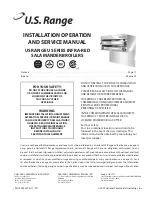
34
shown in Figure 10).
iv. Locate boiler(s) with lowest input closest to
chimney/vertical common vent.
v. Chimney lining must be acceptable for use
with condensing flue gases.
vi. Install a condensate drain to collect any
condensate that may form in the lined
chimney or vertical common vent (refer to
figure 10).
CAUTION
Installing multiple vent terminations close
together promotes frost build up on buildings.
To minimize this possibility, extend the distance
from the building to the end of the vent
termination and increase the horizontal distance
between vent terminations.
4.
Air Intake Piping
a. Consult intake pipe manufacturer for common
air intake pipe sizing.
b. Refer to Figures 11 and 12 for common air intake
guidelines for modular boilers.
c. Individual air intake pipes may be used in lieu of
common air intake piping.
d. Common air intake straight lengths and fittings
should be assumed to have the equivalent length
the same as an individual air intake pipe, used
for a given boiler intake pipe diameter.
e. Position horizontal air intake termination center
line below horizontal vent termination's center
line.
f. Vertical air intake pipe must terminate at least
two (2) feet above the closest portion of the roof.
g. Refer to the Combustion Air section for further
warnings, cautions, notices and instructions.
5.
Water Piping
a. Refer to Figures 13 thru 18 for typical water
piping for modular boilers.
b. Installing a low water cut-off in the system
piping is highly recommended and may be
required by Code, if not factory mounted on
boiler.
c. Refer to Table 1 for pressure drop and flow
requirements for each boiler.
d. Consult I=B=R Installation and Piping Guide.
e. Maintain ½" minimum distance between water
piping and combustible material.
f. Refer to Water Piping and Trim section
for further warnings, cautions, notices and
instructions.
6.
Gas Piping
a. Refer to National Fuel Gas Code, Local Codes
and Tables 2 through 7 for gas pipe sizing.
b. Refer to Gas Piping section for further warnings,
cautions, notices and instructions.
NOTICE
The pressure drop given in Table 1 is for the
boiler only. The pressure drop of each system
fitting and component must be added to the
boiler pressure drop to determine the system
pressure head requirement. See Table 6 for
fitting and component equivalent lengths.
Summary of Contents for EVS SERIES
Page 14: ...14 Figure 4 Vertical Pressurized Venting ...
Page 16: ...16 Figure 5 Typical Negative Pressure Conventional Venting ...
Page 18: ...18 Figure 7 Vertical Air Intake Piping ...
Page 27: ...27 Figure 9a 208 230 460V 1 3 ph 60 Hz Supply Power Wiring Schematic ...
Page 28: ...28 Figure 9b 120V 1ph 60Hz Supply Power Wiring Schematic ...
Page 29: ...29 Figure 9c Standard UL FM CSD 1 Wiring Diagram EVS 500 2000 ...
Page 31: ...31 Figure 9e Standard UL FM CSD 1 EVS 2000S 3000 ...
Page 35: ...35 Figure 11 Modular System Horizontal Air Intake Piping ...
Page 36: ...36 Figure 12 Modular System Vertical Air Intake Piping ...
Page 37: ...37 Figure 13 Modular System Typical One Pipe Water Piping ...
Page 38: ...38 Figure 14 Modular System Typical Primary Secondary Water Piping ...
Page 39: ...39 Figure 15 Modular System Typical Primary Secondary without System Pump ...
Page 40: ...40 Figure 16 Modular System Typical Reverse Return Water Piping ...
Page 41: ...41 Figure 17 Modular System Reverse Return with System Pump Only ...
Page 42: ...42 Figure 18 Modular System Typical Primary Secondary with Reverse Return ...
Page 58: ...58 Figure 19 Combustion Chamber Assembly ...
Page 60: ...60 Figure 20 Burner Assembly FRONT VIEW TOP VIEW ...
Page 62: ...62 Figure 21 UL FM CSD 1 Main Gas Train Assembly ...
Page 65: ...65 Figure 22b DB B Gas Train 500 750 Figure 22c DB B Gas Train 1000 2000 ...
Page 70: ...70 Figure 23 Jacket Panels ...
Page 74: ...74 Figure 25 Pilot Assembly Bishop Design ...
Page 88: ...88 NOTES ...
Page 89: ...89 NOTES ...
Page 90: ...90 NOTES ...
Page 91: ...91 NOTES ...
















































